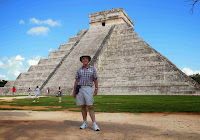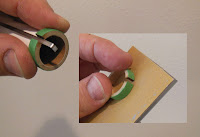The Cherokee D got an first shot of gloss white.
I can't sand until the white coat dries, at least 24 hours in the Florida humidity.
Now that the color coat has been added wet sanding can follow.
When sanding flat surfaces, stay away from the edges.
It's too easy to sand the paint off a sharp corner.
TIP: Notice how the sandpaper is bent away from the sharp edge of the fin. The sandpaper can't roll over the sharp edge if held like this.
If you sand off the paint and go down through the primer (or balsa!) you might have to spray primer again.
To be safe, stay away from the edge by about 1/16". Those edges will take care of themselves and should be smooth in the end.
Here's how the back end looked after "damp sanding" with 400 grit sandpaper.
Look close at the fin on the upper left. I almost sanded through to the balsa! Sand, stop and check - sand, stop and check!
TIP: Pay close attention to the top of the leading edge where it meets the body tube. It's hard to get a Titebond M&TG fillet to roll smoothly around the top.
Wrap some 400 grit around a Q-tip for a cushioned (small) sanding "finger".
One great thing about the Titebond M&TG is it's sandable!
Well, it doesn't sand like a piece of wood, but it's easier to sand than a white glue fillet.
BUILD TIME - Wet Sand White = 25 minutes
TIP: After you spray the first color coat, hold the model up to a bright light and look close at all the surfaces.
Wet sand (actually more like damp sanding) with 400 grit. Sand over any rough areas.
After the next color coat is applied, all those rough areas should disappear. You should have a good gloss surface when the next coats are sprayed.
TOTAL BUILD TIME so far = 4 hours, 5 minutes




















































